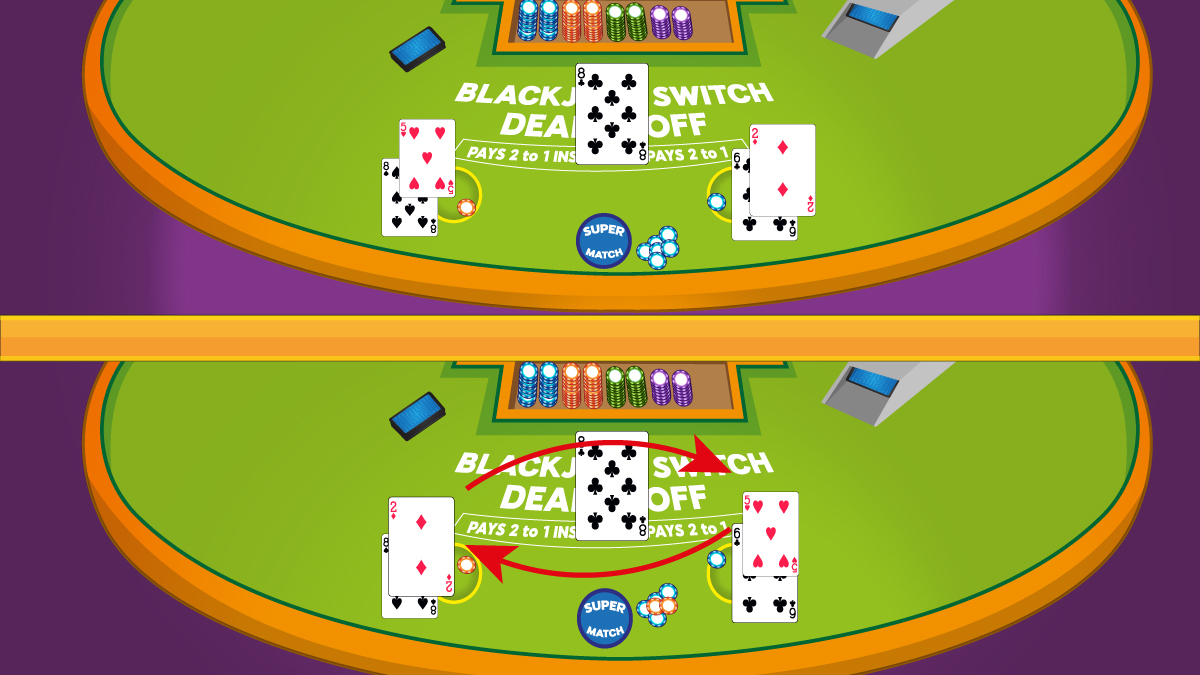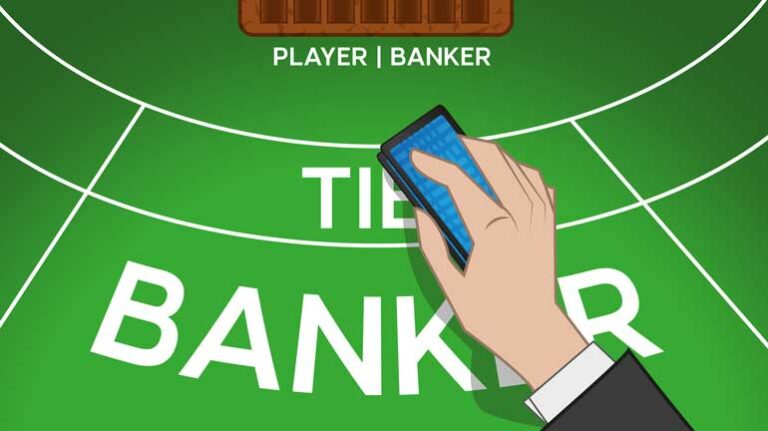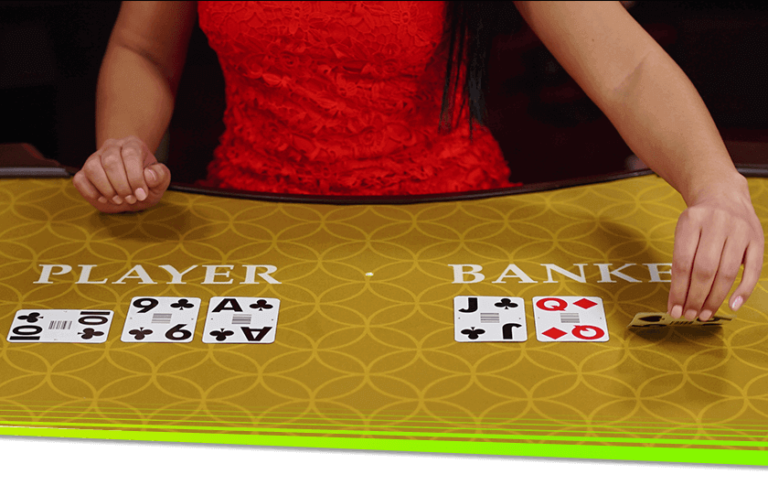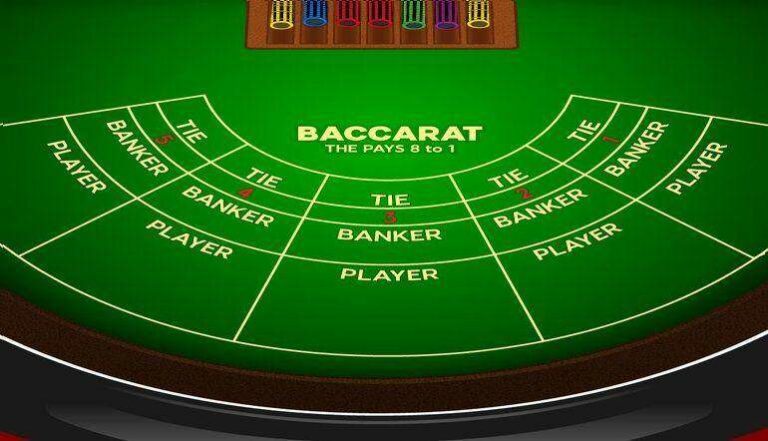Suppose you glanced at your neighbor’s hand and wished that you could switch cards to give yourself a better hand. Of course, you wouldn’t do it because if you were caught, you would be in deep trouble. (Trading cards between two hands is a classic cheating maneuver.) However, with the game Blackjack Switch, you can legally switch your cards between hands.
Table of Contents
- Mechanics of Play
- Playing Rules
- Example of a Switch
- The Catch
- Playing Strategies
- Switching Strategy
- Basic Playing Strategy
- House Edge
- Side Bets
- Card Counting
- Summary
1. MECHANICS OF PLAY
Blackjack Switch is played on a regulation-size blackjack table with a casino dealer. The game is usually played with six decks of cards although casinos have the option to use more, or fewer, decks. Each playing position has two betting spots, instead of one, and a player must make identical wagers on both hands and play each hand independently.
The sequence of how the game proceeds is as follows.
- After each player makes his bets, the dealer will deal one card face up to each betting box and then one card face up to herself.
- Then she deals a second card face up to each betting box and gives one card face down to herself.
- The dealer then asks each player in turn whether he wants to switch the top (or second) card. (You are not allowed to switch the bottom card.)
- If a player decides to switch, the dealer will switch the two top cards in the player’s two hands.
- After a player switches (or not), starting from the hand on the right side of his betting box, he must decide whether to split, double down, hit, or stand, until the hand is completed.
- Next, he must do the same for the hand on the left side of his betting box.
- After all the players have completed making their playing decisions on their hands, the dealer will reveal her down card and hit or stand per the house rules.
- She will then collect all the losing bets and pay the winners.
2. PLAYING RULES
Blackjack rules may differ slightly from one casino to another. However, listed below are the most common rules for Blackjack Switch.
- Usually, six or eight decks of cards are used.
- The dealer must hit soft 17.
- Double down on any two cards.
- Split any two cards of the same rank.
- Doubling after pair slitting allowed.
- Resplitting up to four hands.
- The dealer will peek for blackjack with an Ace or 10 upcard.
- A player may make the insurance bet when the dealer’s upcard is an Ace.
- If a player switches to a blackjack, it counts as an ordinary 21 but does receive a 3 to bonus.
Two additional player-favorable rules that some casinos may implement are:
- Dealer must stand on soft 17.
- Late surrender is allowed.
You must check the playing rules at whichever land-based or online casino you intend to play Blackjack Switch, so you know what they are.
3. EXAMPLE OF A SWITCH
Suppose you are dealt the following two hands against a dealer’s 8 upcard.
| 5 | 2 |
| 8 | 6 |
| Left Hand | Right Hand |
You have a 13 (left) and an 8 (right). By switching the two top cards, you would have these two hands.
| 2 | 5 |
| 8 | 6 |
| Left Hand | Right Hand |
After switching, you have two more favorable hands of 10 and 11, and against a dealer’s 8 upcard, you should double down on both of them.
Being able to switch the top cards in your two hands is a very player-favorable rule. To compensate for this player advantage, there are two catches to this game.
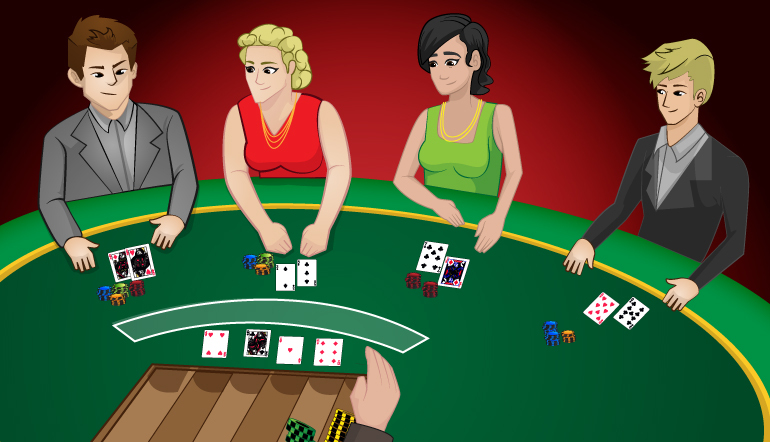
4. THE CATCHES
The two “catches” (i.e., casino-favorable rules) in Blackjack Switch are:
- When the dealer’s hand totals 22, all players’ hands push (except a player’s blackjack).
- All player blackjacks pay even money rather than the customary 3 to 2.
Note: Geoff Hall, who invented and patented Blackjack Switch, also invented Free Bet Blackjack. Both games have the “Push 22” rule.
5. PLAYING STRATEGIES
When you play Blackjack Switch, you need to learn two different playing strategies.
- The strategy for deciding whether or not to switch.
- The basic playing strategy for each hand against the dealer’s upcard.
6. SWITCHING STRATEGIES
Sometimes the decision to switch is intuitive, especially if the two switched hands are more favorable starting hands than the pre-switched hands. I gave one example above with the two starting hands of 8-5 and 6-2.
However, sometimes it is not so obvious whether you should switch. For example, suppose you are dealt A-A and 8-3. Switching would give you these two hands: A-3 and 8-A. Would you switch? (Answer: it’s better not to switch.) However, fear not because there are several published switching strategies for Blackjack Switch. They are:
- A simple, and a more complex switching strategy by Cindi Liu are available on wizardofodds. The latter also has a color-coded strategy chart for switching.
- Another simple switching strategy by Blackjack Hall of Famer Arnold Snyder, is included in his The Big Book of Blackjack, and in the “library” at blackjackforumonline.com.
Here’s a very brief summary of how the switching strategies work.
With Snyder’s switching strategy, you classify each hand as a Winner, Loser, Push, or Chance. For example, “any player blackjack and any hard or soft total that beats the dealer’s total (assuming a ten in the hole) is a Winner.”
Snyder gives the “rules” for classifying other hands into the above four classifications. By using his classification system, a player will be able to make a quick judgment as to whether his hand is more likely to win, lose, or push before and after switching. This sounds difficult, but Snyder has plenty of practice hands to help you learn this technique.
Liu’s simple switching strategy ranks hands in order of strength. (For example, 21>20>19>AA, etc.) You then follow a set of rules such as, “Against a dealer 7 or 8, balance the hands, by making the weaker hand as high as possible, using the above scale of hands, if you can.”
With her advanced switching strategy, there is a table that shows the dealer’s upcard across the top row and down the first column are different player’s hands. At the intersection of your hand and the dealer’s upcard is a number (representing the strength of hand). You then add up the number of points for each hand for both ways to play them and play the one with the greater number of points.
As you see, both researchers used a slightly different approach that a player can use to determine whether you switch or not. My suggestion, if you want to play Blackjack Switch, is to review all three approaches then learn the one that you believe would work best for you. What’s important is that you need to know when to switch cards before you begin playing this game.
Note: Here are two more tools that can help you. There is a switching calculator on wizardofodds.com and a Blackjack Switch Calculator for iPhones.
7. BASIC PLAYING STRATEGY
Once you decide whether or not to switch, your next decision is whether to split, double, hit, or stand. There are differences in the basic blackjack strategy for Blackjack Switch compared to the traditional basic playing strategy due to the push 22 rule; specifically, there will be fewer situations to double down and split, and more to hit (even at the risk of busting).
You will find basic playing strategy tables for Blackjack Switch in the above-mentioned references. You shouldn’t use the traditional basic playing strategy when you play this game; instead, you need to follow the basic playing strategy that is specific to Blackjack Switch.
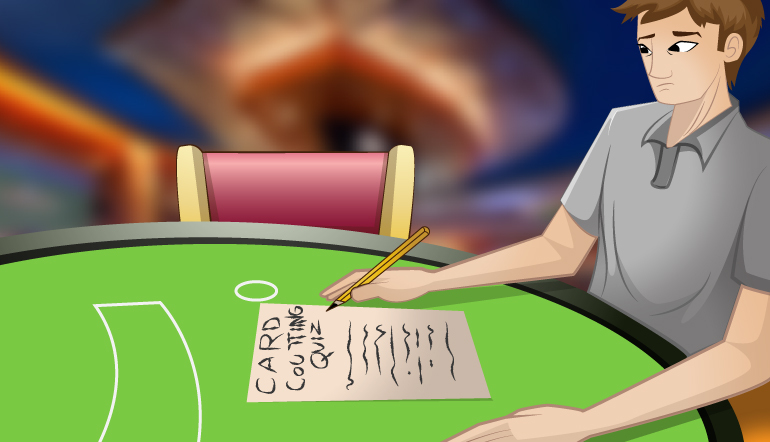
8. HOUSE EDGE
In a six-deck Blackjack Switch game with standard Las Vegas rules, the dealer hits soft 17, and a switched blackjack counts as an ordinary 21 , the house edge by using the basic playing and switching strategies is 0.58%. If the dealer stands on soft 17, the house edge is lowered to 0.28%.
9. SIDE BETS
Some casinos offer a side bet on Blackjack Switch tables. The most common is Super Match, which pays for specific hands based on the four cards in the initial two hands.
An example of the winning hands and their payoffs is pair (1), three-of-a-kind (5), two-pair (8), and four-of-a-kind (40). The house edge with these payoffs is 2.55%, considerably higher than the main game.
10. CARD COUNTING
It’s possible to card count at Blackjack Switch and gain the advantage; however, it requires mastering the switching and basic playing strategies for this game as well as the nuances of a counting system, making it more difficult compared to card counting a traditional blackjack game.
Note: The cards are usually reshuffled after each round in online blackjack games, including Blackjack Switch. Therefore, card counting would not work. In addition, many European casinos use the no-hole-card rule, which requires a modification to the basic playing strategy.
SUMMARY
- You must play two hands in each round with identical bets on both hands.
- You have the option to switch the top cards in both hands.
- It’s important to learn a switching strategy for this game.
- The basic playing strategy is slightly different from the traditional basic playing strategy and it should be learned.
- To compensate for the above player advantage by switching, when the dealer gets exactly 22, all player hands of 21 or less are pushed (except a player’s blackjack).
- A player’s blackjack is paid at even money.
- The house edge using a switching strategy and the basic playing strategy for this game can be as low as half a percent (even lower, rule dependent).
- The game is available in land-based and online casinos.


